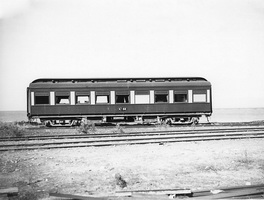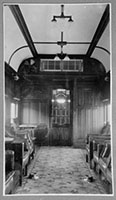
The Commonwealth
Railways commenced construction of the Port Augusta to Kalgoorlie Railway in
1912. It was proposed from onset to make this a world class railway. Initially
seven wooden sitting cars were purchased from Clyde Engineering Company of New
South Wales. The Commissioner proposed that these cars only be used on
construction trains as all steel passenger rollingstock was to be obtained for
the through express. Plans were drawn up in 1915, but unfortunately due to
political pressures and a world steel shortage caused by the war in europe,
construction was postponed. Alternate plans were formulated for Australian
built wooden cars, with each train accommodating sleeping, dining and parlor-buffet
cars.

The parlor-buffet cars as proposed consisted of two compartments with loose lounge chairs and a buffet from which light refreshments could be purchased. It was initially intended that these cars should be built from the body shells of two surplus Clyde built sitting up cars, but was abandoned when it was determined that four (4) lounge cars were to be constructed in place of the proposed parlor-buffet cars.
Lounge
accommodation was now provided by the building, at Port Augusta Workshops, of four
(4) clerestory roofed wooden bodies which were placed on surplus flat car
underframes formerly used on construction trains. Each cars was 51 feet 2 inches
(15.56 metres) in length and 10 feet (3.05 metres) wide with no end platforms as
had been found on all earlier purchased rollingstock. A novel feature of these
cars was the lack of any side doors. Passengers could only leave the train by
passing through the connecting doors into another carriage.


The cars were coded "AF" and given road numbers 24 through 27. Prior to the completion of "AF 27", the Commissioner decided the Governor General would need a special car for use during the inaugural train run on 20.10.1917, this resulted in "AF 27" temporarily being fitted out with compartments, dining room, toilets and support staff accommodation. Each lounge car cost £3530/9/5 ($7060) and was fitted with plush lounge chairs, writing desk, mirrored panels and hand coloured scenic photographs. Two compartments were provided in each car, one for women, the other for men, being divided by a wooden central partition. Shortly after entering service, these compartments were reclassified as smoking and non-smoking, rather than along traditional sexist lines.
During July 1917, another attempt was made to convince the Commissioner to purchase an all steel parlor-buffet and also a dining car from the Pullman Company of U.S.A. The Chief Mechanical Engineer intended to use these cars as prototypes for additional vehicles that would be constructed in Australia, thus overcoming the political view that it was unpatriotic to purchase all the required vehicles from overseas. The additional vehicles proposed would replace the light wooden vehicles constructed earlier as a temporary expedient when it had become obvious that steel rollingstock could not have been obtained without delaying the opening of the railway. Some of the arguments he used against the existing rollingstock included
"The type of construction, that is, steel underframes and wooden bodies has been discarded in the United States of America and Canada for a number of years and is not considered suitable for high speed service. Should an accident occur such cars are more liable to collapse than the steel bodies now used on the best trains.
The construction of the body is of such a character that they will be comparatively noisy, are partly insulated, poorly ventilated, and probably will be very dusty and drafty.
Owing to the extemporised type of car now being obtained, satisfactory vestibule connections cannot be adopted, and this factor, with special attention to dust proofing, is an essential in up to date cars."
A consequence of this report was improved wooden passenger car designs incorporating longer car bodies, roomier compartments, showers, vestibules with concertinas and turtle back (elliptical) roofs.
Complaints from
passengers about ventilation and heat problems, resulted in all opening windows
of lounge cars being fitted with outside louvres in 1919. Instructions issued
to porters advised them that the louvres should only be lowered on the sun side
of the carriage, so as to not obscure the scenic views.

After a visit by the Commissioner in 1920, two (2) pianos were hired for use in lounge cars. The first was installed on 7.4.1920. The few passengers who were upset by this innovation wrote letters to national newspapers. The Argus of 5th May 1920 had the following to say
"The Commonwealth Railway Department has added a new terror to the trials of modern travel by installing pianos in the lounge cars of the Great Western Railway. In a hotel one can escape; on a steamer there is always refuge; but for the victim of the musical enthusiast in a railway train there can be no hope. The pianos are being installed for three months just to ascertain how they stand it, but there is not a word of trying to find out how the passengers will stand it. It is just the thin end of the trombone, and is the forerunner of the jazz band with a lady conductor, who will doubtless be annoyed is she is address as the misconductor, and don't blame her either."
But, by far the bulk of passengers were only too happy to praise the piano and condemn other railways for not providing similar diversions. The two pianos were purchased three months later.
By this time three
carriage consists were in use on through express trains, preventing the removal
of a lounge car for routine maintenance. Approval was granted on 15/1/1923 for
construction of a new lounge car using the improved carriage styling that had
previously been trialed on new sleeping cars and the special service car "SS 44".
Entering service on 14.12.1923 at a cost of £5056/16/3 ($10112), the car
was of a similar basic design to earlier cars but paraded more luxurious
fittings. "AF 49" as the car was designated was fitted with two compartments
divided by a wooden partition. Enhancements included an ornate bevelled glass
door, matching light fittings, oval cathedral glass windows at either end,
turtle back roof, exterior louvres, polished wooden interior and a pressed
metal ceiling by Wunderlich. The leather lounge chairs were considered so
comfortable that in 1925 the Victorian Railways (VR) borrowed two using them as
prototypes for new chairs to be included in a refurbishment of VR parlor cars.


Stones air-conditioning was installed in "AF 49" in February 1936, making it the first car on the Commonwealth Railways to be so fitted. It provided to be so popular that all other lounge and dining cars were fitted between 1937 and 1939 as funds could be made available. It had cost £2895 to air-condition "AF 49".
Governor General's car "AF 27" was temporarily returned to a lounge car in 1941, becoming permanent in 1946. It lacked air-conditioning, being only used as a replacement car when other lounge cars were being serviced or repaired. Ultimately placed in storage in the car barn in the early 1960's, it eventually became an office used by the carriage cleaners until being transferred to Peterborough Workshops in August 1988 for refurbishing.
So far all the lounge cars discussed have been for the use of first class passengers, second class passengers were provided for by the conversion of four (4) of the original sitting up cars purchased from Clyde in 1915. The conversion to "BRPF" in 1917 involved fitting four (4) person sleeping compartments at one end and open plan fixed position seating at the other to form a smoking saloon. Cars converted became "BRPF" numbers 1, 2, 4 and 5. The lounge compartments of these cars were never very popular and were all gradually replaced when the german Wegmann cars arrived in 1953, ultimately ending up as various types of service vehicles including a breakdown train sleeper and the Tea and Sugar's community service car.
As part of the post war reconstruction the Commonwealth Railways purchased two modern air-conditioned trains from the Wegmann Company of Germany. Included in each consist was a first class lounge car, a combination second class sleeper-lounge car and a combination first class sleeper-observation lounge car. The new cars were considered world class, using only the finest materials. The body of each car was of steel with wooden interiors featuring extensive marquetry and fittings of brass.
Purchasing a modern all steel train forced the Commonwealth Railways to upgrade most of its wooden rollingstock. In 1954 a single second class sleeping car had one end converted to an air-conditioned second class lounge modelled on the new Wegmann rollingstock. Fixed seating was placed either side of a centre walkway. The car, originally coded "BR 54" was recoded "BRFA 54", becoming "NBRF 54" when converted to narrow gauge Ghan service in 1961. This vehicle was converted to the Mobile Education car in 1982 and is coded "EH 54". The sleeping and lounge compartments were replaced by teaching and storage facilities.
Tourist trains were introduced on the TAR in 1960 and as a result, "AF 24" was fitted with a cocktail bar, refrigerator and wireless until withdrawn in 1968 and placed in storage. "AF 25" and "AF 26" were refurbished in 1961 and when, later the same year, improved services were provided on the Ghan, "AF 25" was outshopped on narrow gauge bogies for service on the Central Australia Railway. It was a regular sight on the Ghan until returned to Standard Gauge in 1974 when fitted out with shelving for use as a mobile showroom on the "Tea and Sugar".
The Railway Institute Model Railway Club obtained use of "AF 26" in 1970, having it placed behind the Institute building in the Port Augusta Yard. "AF 24", "AF 25" and "AF 49" were sold to Steamtown Peterborough in 1979, when they were all stored in the Port Augusta car barn, along with "AF 27". "AF 49" is now in Steamtown service on narrow gauge and the other two await restoration.
| Number | Entered service | Write off | Notes |
|---|---|---|---|
| AF 24 | 20.10.1917 | 3.03.1979 | To Steamtown |
| AF 25 | 24.11.1917 | 3.03.1979 | To Steamtown |
| AF 26 | 31.10.1917 | To Railway Institute | |
| AF 27 | 20.10.1917 | Governor General"s car | |
| AF 49 | 14.12.1923 | 26.05.1979 | To Steamtown |
| BRPF 1 | 18.08.1915 | To Camp Sleeper (XE) | |
| BRPF 2 | 18.08.1915 | 15.11.1986 | To Camp Sleeper (EE) |
| BRPF 4 | 2.10.1915 | 20.10.1969 | |
| BRPF 5 | 2.10.1915 | 3.1988 | To Welfare car (OW) |
| BRFA 54 | 20.12.1930 | To Education car (EH) |
1. Commonwealth Railways and Australian National rollingstock record cards, diagrams and plans.
2. Commonwealth Railways general correspondence files.
3. Commonwealth Railways general appendix, 1st May 1924, 1st August 1932, 1st March 1950.
4. Steamtown Peterborough Railways Preservation Society, Steve McNicol, 1980.
5. Commonwealth Parliamentary Papers, Commonwealth Railways annual reports to parliament with appendices, 1916-1940.
6. Commonwealth Railways Trans-Australian Railway Time Table, Description of route and general information, 15th April 1919.